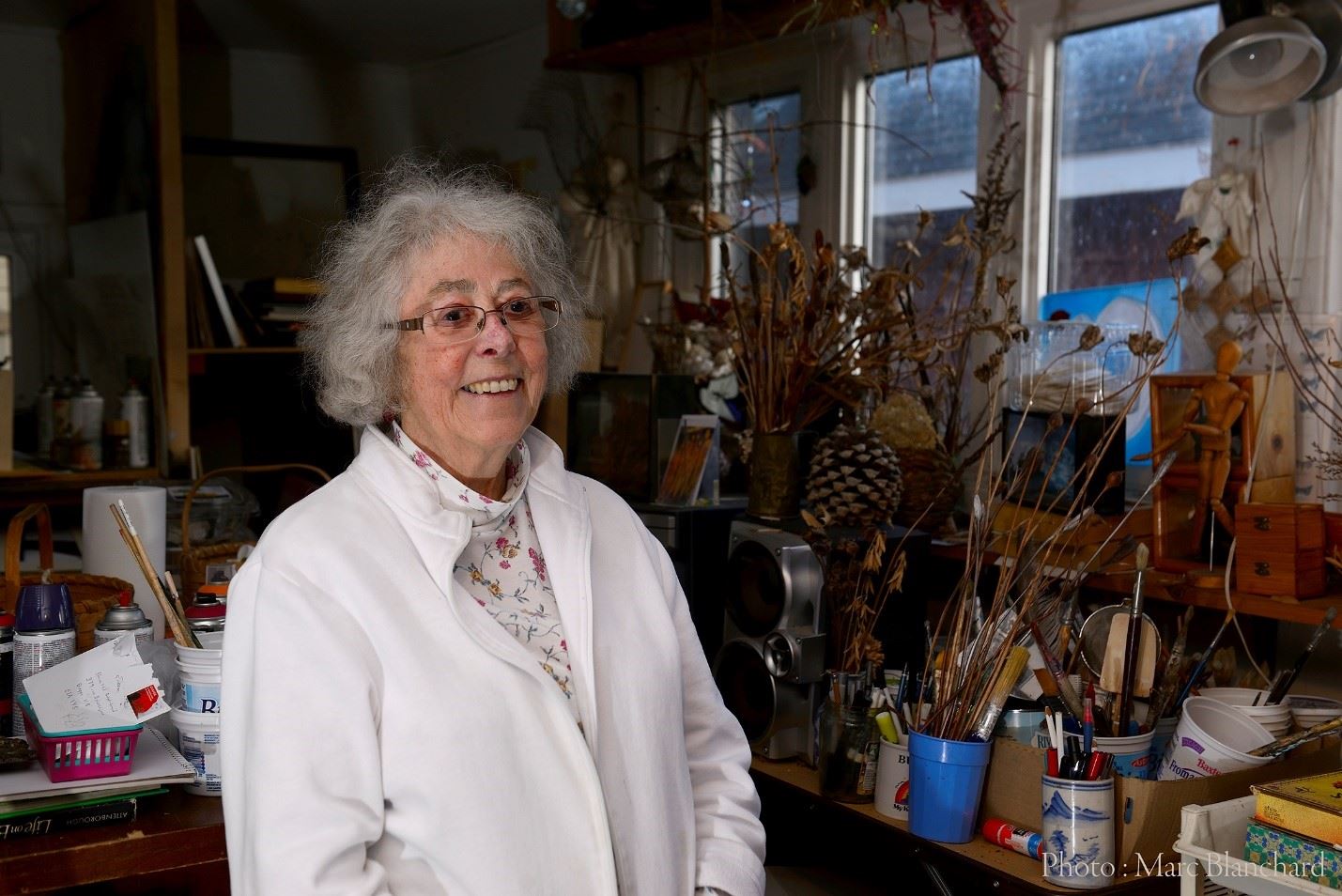
(Artist Elaine Amyot in her studio. Photo credit: Marc Blanchard, http://www.marcblanchard.ca )
Submitted by Elizabeth Blanchard
I was introduced to Elaine Amyot 18 years ago at a meeting of the Breach House Gang, a group of writers who met, and still do, every month in Nancy King Schofield’s studio on chemin La Brèche. It was during one of those Sunday afternoon gatherings that I remember Elaine reading from a draft of Les Pierres de Paris, a non-fiction piece about her childhood memories that would later go on to place in the WFNB Literary Competition. I was struck by the description of the “rose-coloured glass doors” of her mother’s bedroom; the fine lines of her mother’s vanity table; and the details of the mechanism that secured the lid to the “honey-coloured” box that held les Pierres de Paris, the kind of detail that, for most of us, goes unnoticed in the course of a day. Clearly, Elaine had recorded her memories with the care and aesthetic sensitivity of a visual artist.
A visual artist whose work I had the privilege of writing about when Elaine later invited me to produce essays for her upcoming exhibitions, seven in all between 2008 and 2015.
 With her easy smile and keen sense of humour, Elaine was the warmest of hosts. We would sit at her kitchen table and spend the afternoon talking about her art over a cup of tea and something sweet. Extremely well-read, she carried with her a small notebook in which she transcribed passages from works that resonated with her, Gaston Bachelard’s The Poetics of Space among her favorites. Often, when discussing a particular piece, she would recite the lines of poetry that had inspired the work. Literature fueled her imagination and seemed a great source of joy; a passion she shared with Ed Lemond, her husband of 25 years.
With her easy smile and keen sense of humour, Elaine was the warmest of hosts. We would sit at her kitchen table and spend the afternoon talking about her art over a cup of tea and something sweet. Extremely well-read, she carried with her a small notebook in which she transcribed passages from works that resonated with her, Gaston Bachelard’s The Poetics of Space among her favorites. Often, when discussing a particular piece, she would recite the lines of poetry that had inspired the work. Literature fueled her imagination and seemed a great source of joy; a passion she shared with Ed Lemond, her husband of 25 years.
We talked at length about the different art forms she used to express her creativity. Whenever I asked about the significance of an object she had incorporated into one of her assemblages, she would speak not only of its lines, texture and symbolism, but also of its story. She’d recount the time, place, and circumstances by which the item came into her possession. And if the item had been given to her, she’d reflect on the thoughtfulness of the friend and the warmth of the gesture.
Through our discussions, I came to appreciate and better understand Elaine’s profound respect for nature, an element ever-present in her work. We often visited her studio, which was housed in a small gabled-roof structure in her back yard. Among the canvases, the easels, and the recycled containers full of paintbrushes, she kept brittle stems of goldenrod, cattails stalks, large pinecones, and pieces of driftwood whose surfaces had been smoothed by the sea; “a work of nature, not of man,” she was quick to point out. Elaine explained that, with her art, she explored landscape as a reflection of our own internal nature. On one occasion, she retrieved a yellowed leaf that had been pressed between the pages of a heavy book, and pointed to how the fractal pattern of its veins repeated itself the length and width of the leaf at increasingly smaller scales. Where I would have probably seen only shape and color, Elaine saw the beauty and intelligence of expanding symmetry.
I very much like the thought of the eternal in Elaine; I find it comforting.
We will miss her dearly.

